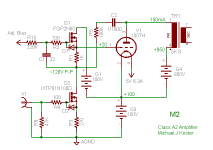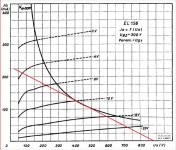Ok, going way out on a limb here perhaps but, is there a valve in existence, a large transmitting tube perhaps, that is capable of producing 15-20W in a single ended design, with no driver? I imagine it being some super high voltage monster, is there a valve that could do it or is it a pipe dream?
I'm going out on a limb and saying no. To get 20 watts from a single tube you are going to need a bunch of transconductance, that rules out most big transmitting tubes. You are going to need at least 40 watts of plate dissipation, probably more like 60+. That rules out most small high transconductance tubes.
I can crank just over 40 watts out of a single 845 and about 38 watts out of a 211. Either of these need about 1000 volts of B+ and hundreds of volts of drive. Not available from most CD players.
The E130L is a 27 watt tube with a transconductance of 27000. It will crank out about 15 watts in pentode mode. You still need about 15 volts P-P of drive to get there without any feedback. Still not quite driverless.
The last resort? The 6HV5A and relatives. Transconductance is 65000, Mu is 300, plate dissipation is 35 watts. The plate is big enough to eat a bit more than 35 watts. So. it's a done deal, right? Not so easy. The tube needs a bunch of voltage, and it's plate resistance is real high, so feedback is almost mandantory. I have experimented a bit with this tube and have yet to tame it. Good luck!
I can crank just over 40 watts out of a single 845 and about 38 watts out of a 211. Either of these need about 1000 volts of B+ and hundreds of volts of drive. Not available from most CD players.
The E130L is a 27 watt tube with a transconductance of 27000. It will crank out about 15 watts in pentode mode. You still need about 15 volts P-P of drive to get there without any feedback. Still not quite driverless.
The last resort? The 6HV5A and relatives. Transconductance is 65000, Mu is 300, plate dissipation is 35 watts. The plate is big enough to eat a bit more than 35 watts. So. it's a done deal, right? Not so easy. The tube needs a bunch of voltage, and it's plate resistance is real high, so feedback is almost mandantory. I have experimented a bit with this tube and have yet to tame it. Good luck!
Yeah, it sounds like a lot more trouble than it's worth even if it was possible. I guess it was just appealing because it hasn't been done before.
Since pretty much that could be done with tubes has been done ... decades ago, one must wonder why what you're after hasn't been successfully implemented. Could it be because it is unfeasable ?
On a related note, what is the highest wattage spud you've seen? The original post title said "single tube", so I'll say it counts even if that tube has a triode and a pentode all in one bottle. Are there any really big compactrons out there? I found the 6MY8 (and 16MY8, 21MY8) that claims 16 watts dissipation on the pentode section. How many audio watts can you squeeze out of that?
Last edited:
You don't say that the line input has to drive the grid directly so... It could be done with a couple of MOSFETS driving the grid of a 100TH with current mode plate feedback.
About 25W at the plate, 20W+ output depending on OPT. 80W dissipation + 30W filament.
michael
OOPS grid is actually +20 wrt the filament so make that +120 from ground.
About 25W at the plate, 20W+ output depending on OPT. 80W dissipation + 30W filament.
michael
OOPS grid is actually +20 wrt the filament so make that +120 from ground.
Attachments
Last edited:
Ok, going way out on a limb here perhaps but, is there a valve in existence, a large transmitting tube perhaps, that is capable of producing 15-20W in a single ended design, with no driver? I imagine it being some super high voltage monster, is there a valve that could do it or is it a pipe dream?
The 845 can do 20W SE easily. That's what it was originally designed for: AF final for high powered, plate modulated, AM transmitters that could conveniently share power supplies with the RF finals. Of course, that means running these at some serious voltages: ~1000Vdc. It just so happens that the 845 also sounds pretty good as well, so SETs don't always have to be anemic amps that need special speeks, or are only good for headphone duty.
As for as "with no driver" is concerned, what does this actually mean anyway? It will always need some sort of driver, even if it's incorporated into some other device. To get that 20W of output, an 845 will need to see 310Vp-p at its control grid.
The driver stage is needed because it is what does the voltage amplifying. The output tube needs a high enough input voltage on its grid (or however it is fed) to put out the wattage. You may be able to drive a power tube directly from a regular power amp though, through a transformer.
The driver stage is the most important and complex part of the amplifier, but with interstage transformer coupling you can reduce the driver components to get closer to your idea of having no driver stage. Actually a transformer would be sensible on all elements of the tube, that is the grid, plate, and even the cathode (twin coupled, cathode windings, or cathode follower.)
And www.electra-print.com comes close to answering your question as well.
The driver stage is the most important and complex part of the amplifier, but with interstage transformer coupling you can reduce the driver components to get closer to your idea of having no driver stage. Actually a transformer would be sensible on all elements of the tube, that is the grid, plate, and even the cathode (twin coupled, cathode windings, or cathode follower.)
And www.electra-print.com comes close to answering your question as well.
Any thoughts on an 811A? I've come across a few SE designs utilizing them.
With the right design, these can sound really good. Being that this was designed to be a "zero bias", RF final, it will require positive bias to set a SE Q-Point, and a stiff driver to supply the grid current it will need. Here, think source follower.
It may also require some assistance from local NFB. This is a high-u triode, and that means a high r(p) that doesn't play well in terms of speaker damping, and, given the higher than normal r(p), the possibility of more h3 and higher order harmonics than you'd expect from low-u, audio type triodes. You may also need some gNFB to clean that up.
I guess one could get almost 25W out of an EL156 with an input stepup transformer, run right on the edge of it's 50W (autobias only) dissipation limit.
There's no way to apply any NFB given the input signal is barely enough, so there will be no speaker damping to speak of.
But it could be done...
There's no way to apply any NFB given the input signal is barely enough, so there will be no speaker damping to speak of.
But it could be done...
Attachments
Here is the single tube single stage 45W amplifier.
http://spbsound.narod.ru/SPbSound/schematic/schematic2.html
I read that some people build it in Russian forums.
Some people in Japane did similar as well as I heard.
I would like to repeat it at less powerfull tubes but did not find the scheme.
http://spbsound.narod.ru/SPbSound/schematic/schematic2.html
I read that some people build it in Russian forums.
Some people in Japane did similar as well as I heard.
I would like to repeat it at less powerfull tubes but did not find the scheme.
Here is the single tube single stage 45W amplifier.
http://spbsound.narod.ru/SPbSound/schematic/schematic2.html
I read that some people build it in Russian forums.
Some people in Japane did similar as well as I heard.
I would like to repeat it at less powerfull tubes but did not find the scheme.
So that is an 833A with 2300 Volts on the plate?
WHOA!
- Home
- Amplifiers
- Tubes / Valves
- Single tube, Single ended, 20W, impossible?

